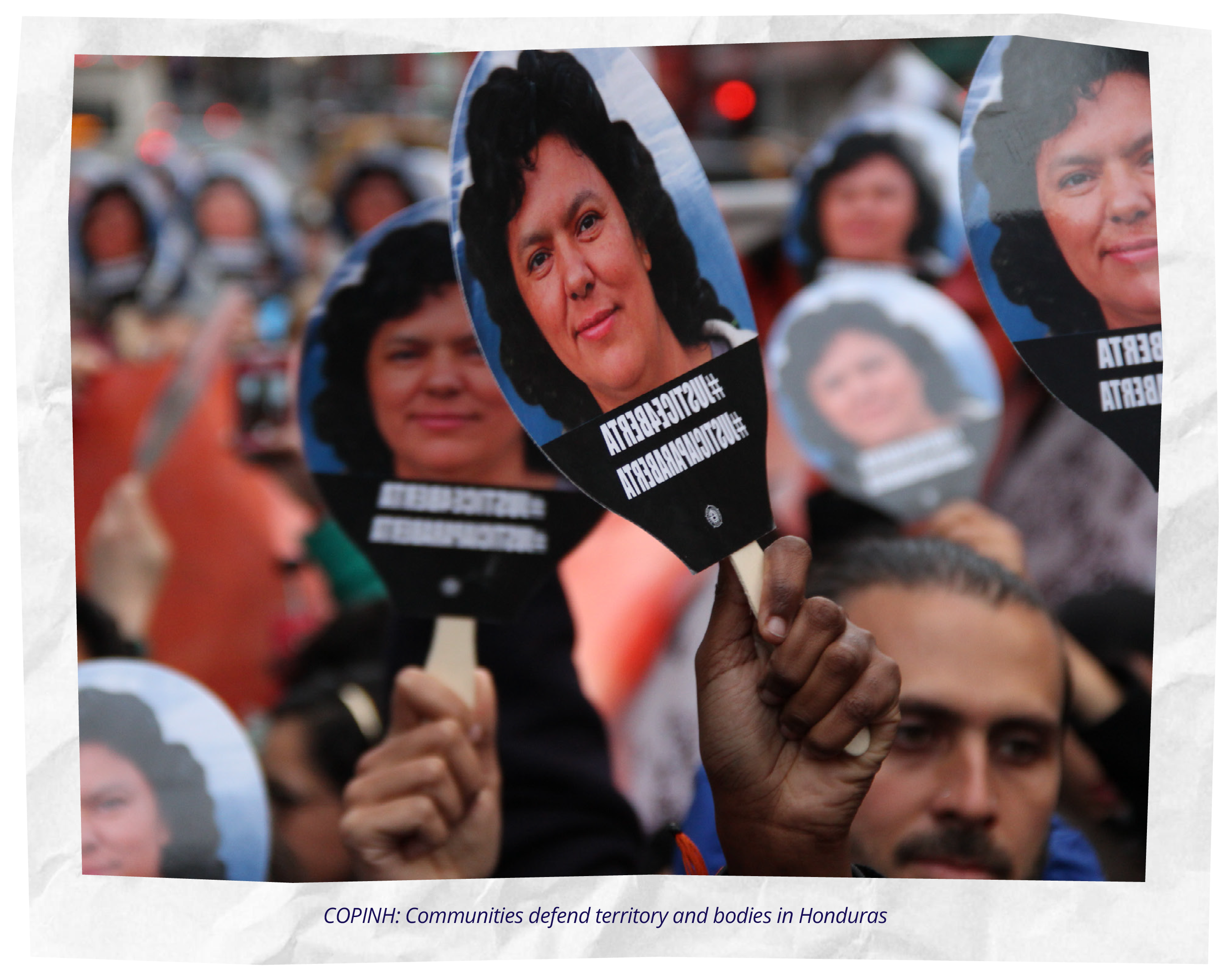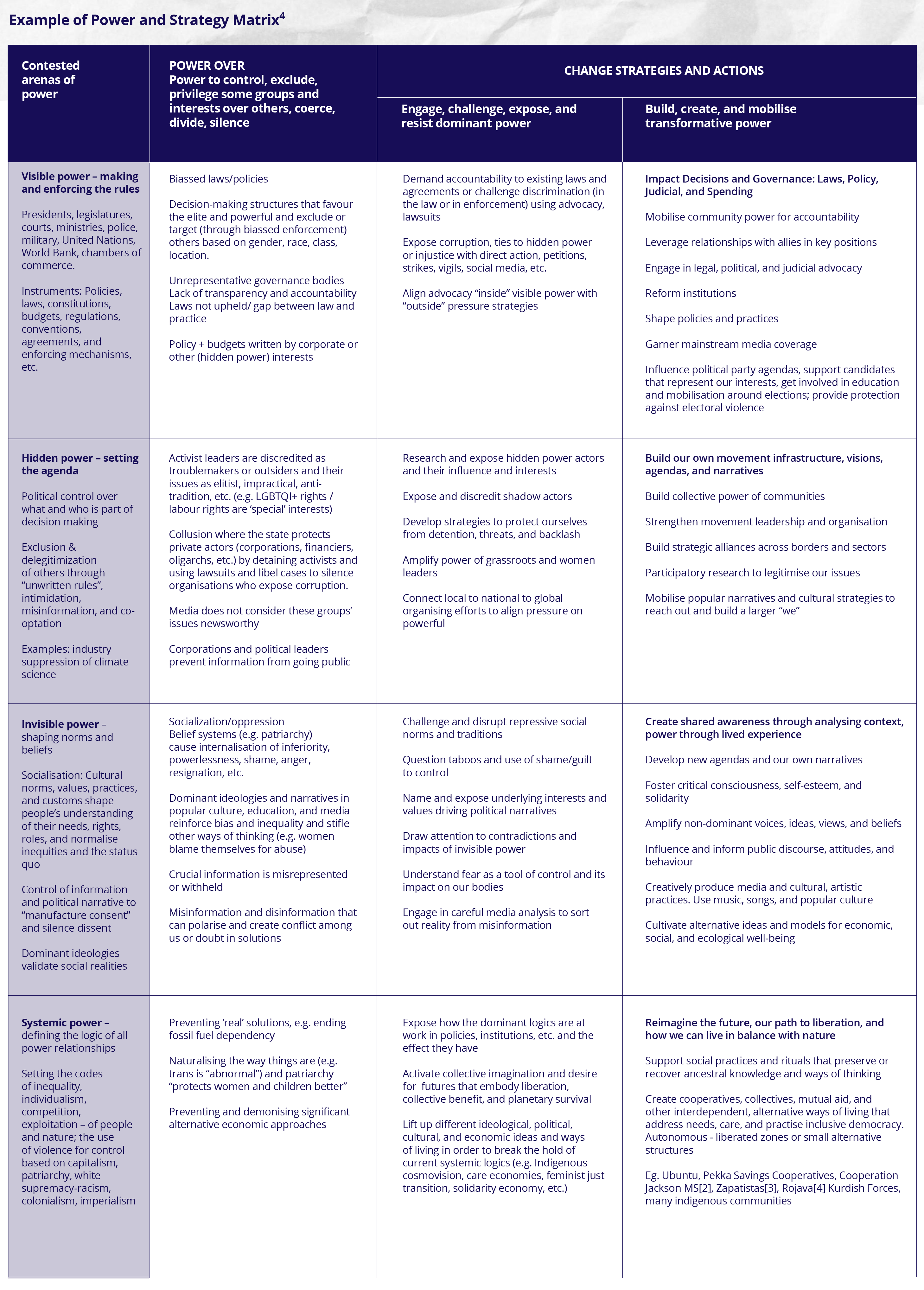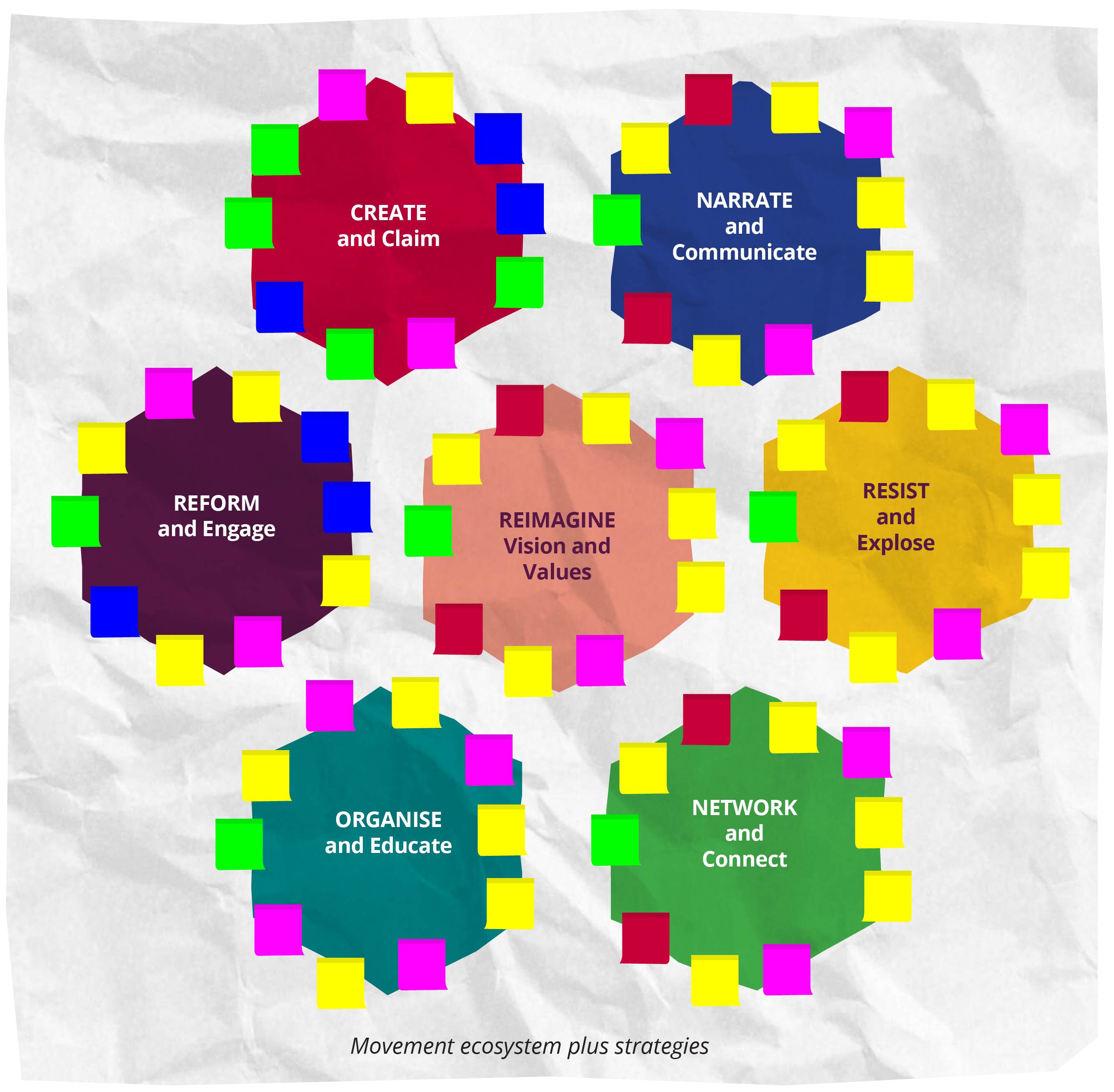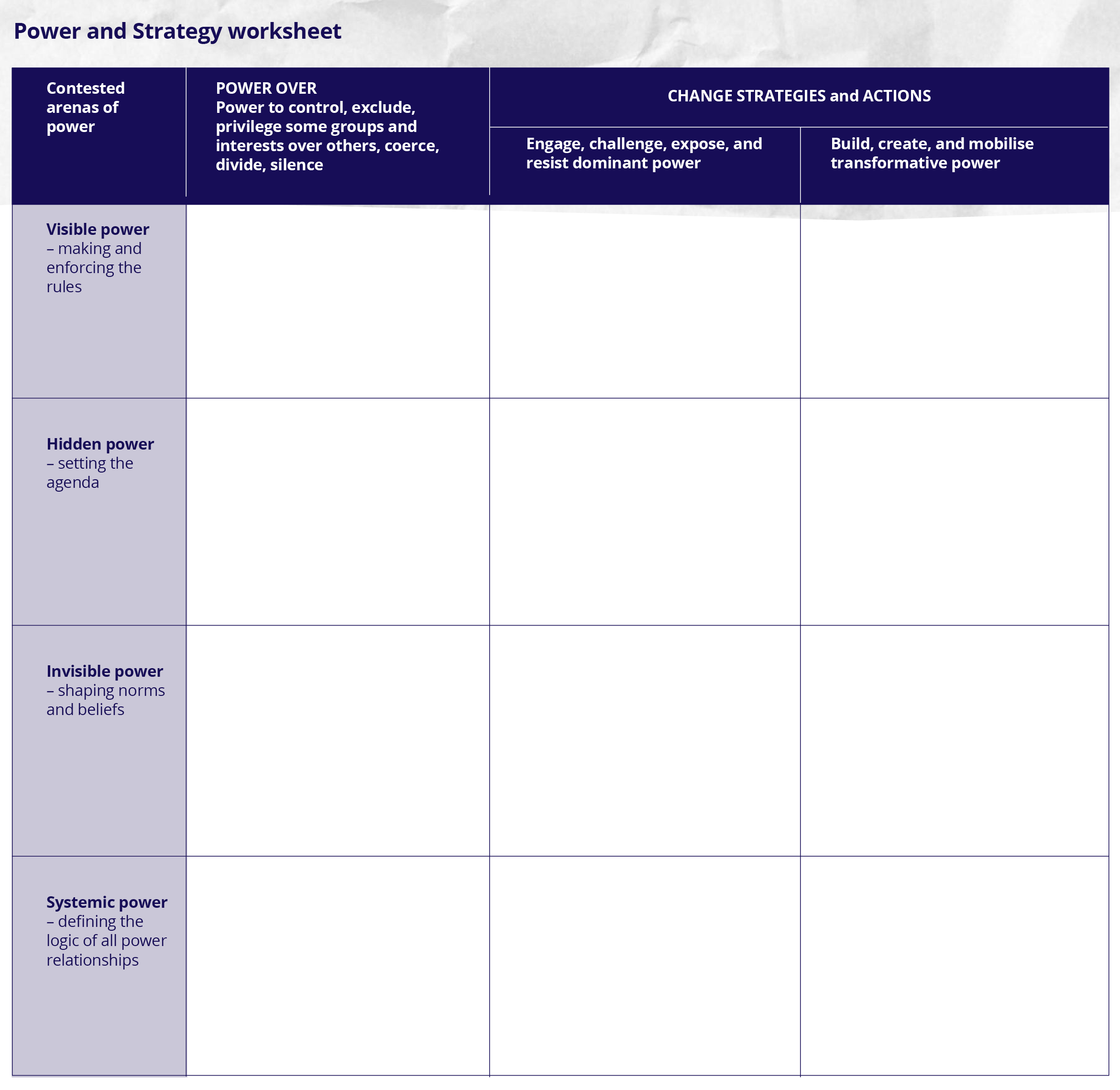Theme 2: Connecting Analysis to Strategy
Strategy development requires layers of power analysis and information-gathering. In order to make strategic choices for both long-term power-building and short-term tactics we must identify:
- The overall dynamics and actors shaping the situation we want to change.
- More specifics about who (the players and decisionmakers and their relationships) and what (for example, norms, beliefs, and narratives) we’re up against and what their agendas and interests are.
- Where the opportunities, contradictions, unexpected allies, and levers of change may be, outside or inside the structures we seek to change.
- Potential risks and precise conflicts, and how to mitigate and prepare for them.
- How and with whom we can build and leverage power.
- What we are demanding, exposing, and blocking, and what are we working to change and create.
- What story and narrative support the change we seek.
In developing strategy, details matter. This section therefore draws on the Guardians of the River case study, which offers specific lessons about the factors shaping strategic choices, as well as a range of possible strategies and tactics. It is illustrative of the possibilities of connection with the broader movement ecosystem and about the specifics of context, issues, and actors.


Download this matrix.
Activity 4: COPINH’s strategy
Materials: Case study: Guardians of the River; large copy of the handout: Movement ecosystem graphic on the wall; copies of handout: Power and Strategy worksheet; sticky notes or cards in four different colours.

Step 1: Connecting COPINH’s power analysis and strategic choices
Plenary: Place a large Movement Ecosystem on the wall with space to add stickies around each strategy. Download, share, or refer to the example of a power and strategy matrix.
Use the Power and Strategy worksheet to take a more nuanced look at how different arenas of power require different strategies for resisting and building power. The two right hand columns invite different kinds of observations about strategy. In the column labelled “Engage, challenge, expose, and resist dominant power”, note actions COPINH took to confront and shift the power dynamics and actors in the context. In the column “Build, create, and mobilise transformative power”, note the ways in which COPINH built their transformative power, including the more internally focused activities that strengthened their cohesion.
Introduce the small group activity and form four small groups. Assign one colour of sticky note for each arena of power.
Small groups: Use the Power and Strategy worksheet to analyse the struggle of COPINH (and the wider movement) against the Agua Zarca Dam. For each arena of power, note specific examples of power over in the first column:
- Who and what are the actors, structures, and forces that contribute to the problems that COPINH is confronting?
- In the case of specific actors, what are their interests? Remember that strategies and power dynamics operate at local, national, regional, and international levels.
Note answers in any or all of the three columns:
- How does identity – particularly gender, ethnicity, class, and location – play out in each arena of power, both in terms of discrimination and violence, and in relation to strategy, as a potential source of community and narrative-cultural strategies?
In the second two columns, identify the strategies used by COPINH and their allies to challenge and build power in each arena – both to oppose the dam and to build and exercise their own power:
- What were the different entry points, angles and possibilities for challenging the construction of the dam and the political repression accompanying it?
- At the global level, how did the US Congress figure in COPINH’s power analysis and strategies? What was the role of the legal system?
- What about other global, regional, and international institutions?
- How did COPINH and their allies build, mobilise, and exercise their power?
- How did COPINH engage, challenge and contest ideas, beliefs and narratives? How did they activate different belief systems and views of the world?
As a final step, pick key strategies (maximum three) used by COPINH or their allies, and write these on the sticky notes, using the colours assigned for each arena of power.
Plenary: Groups take turns to share highlights from the power over column, building on each other’s contributions rather than repeating. Focus on how the different arenas of power intersect and involve converging structures, actors, and dynamics. Invite each group in turn to share the COPINH strategies they identified, starting with those for contesting visible power, then moving to hidden, invisible, and systemic.
Step 2: COPINH’s Strategies in the movement ecosystem
Plenary: Examine the range of COPINH strategies in light of the broader movement ecosystem. Invite small groups to place their sticky notes on the Movement Ecosystem, near the relevant area of strategy.
Notice any patterns, such as colours of sticky notes clustered around certain kinds of strategies, or gaps where there are fewer strategies.
- How did COPINH build and mobilise their power to resist or block the building of the dam?
- What organised capacity was COPINH able to activate in their resistance – members, allies, etc?
- How did they use and influence legal mechanisms and policy spaces to advance and draw attention to their agenda and defend their rights?
- What resources, capacities and alliances did they require?
- How did they turn up the heat on decision makers and expose corrupt abuses of power through direct action?
- How did they continue to build and mobilise relationships with allies both inside and outside structures of power, within movements and across borders?
- How did their vision and values shape their strategy and their narrative, and serve as the foundation of their power?
Share and discuss the handout: Lessons from COPINH.
Step 3: Vision and values
“In our worldview, we are beings who come from the earth, the water and the corn. The Lenca people are ancestral guardians of the rivers… [taught] that giving our lives in various ways to protect the rivers is to give our lives for the well-being of humanity and of this planet.” Berta Cacereres, Goldman Prize acceptance speech
Plenary: An effective long-term strategy is always anchored in a clear vision, explicit values, and a bold ambition or intention. COPINH’s vision and values provided a continuous touchpoint for the political culture it seeks to create, and its community-building, demands, and narratives.
Buzz groups: Use stickies and a brainstorming process to generate words and phrases that capture COPINH’s vision, values, and bold ambition.
Plenary: Read aloud the quote from Berta Cáceres’ speech when she won the Goldman Environmental Prize (duplicated above). Discuss:
- How do you think COPINH’s vision and values shaped their strategy and strengthened their base of community members and allies?
- How did COPINH’s years of community building and other groundwork strengthen their power and fortify their resistance?
- From your own experience or study, how do vision and values shape and strengthen the strategies, agendas, and ways of working of organisations and movements?
Download this activity.

Download the worksheet.
Lessons in movement strategy from COPINH
Strategy development relies on many layers of analysis and information gathering about power, which can be an important organising and leadership-building process in itself.
Deep, continuous community building and involvement is vital for unity and united action.
Forging local alliances, and ties with friends and allies around the world – inside formal structures of power, the media and in movements – are vital to the ability to mobilise support, build clout and have influence.
Cultural strategies – in COPINH’s case, rooted in indigenous identity, practices, and cosmovision – feed and sustain a sense of community, shared commitment and unity.
When analysing power, it is not enough to name a ministry or ‘the army’ in general. Rather, identify specific decision-makers and structures. As you further refine the targets of tactics and influence, explore where you might find allies and whether there are conflicts, contradictions, and opportunities among actors, particularly at regional or global level. These can provide strategic opportunities.5
Multi-pronged strategies offer more points of leverage and more pathways to challenge, resist and create change.
Some actors and forces are hard to identify with a specific arena of power or may come up in more than one arena. Examples:
- Corporate or privately-owned media companies are clustered as hidden power because they operate outside the formal arena of power to influence public discourse and perceptions. They may play both negative and positive roles and are essential to consider in strategies.
- Police, military and public and private security forces may play both negative and positive roles in relation to upholding or challenging the status quo. While their actions tend to be in the visible power arena, they sometimes work in alignment with hidden, invisible and systemic power.
- Digital media can play positive or negative roles. Many use social media for activism and as a source of information, organising, and connection, despite knowing that these tools are controlled by private, loosely regulated corporations that enable surveillance, polarisation, and misinformation.
- Political parties can be difficult to categorise, but because they contest for formal power, they fit in visible power for analytical purposes.
- The UN, World Bank, the IMF, and related trade mechanisms fit in visible power because they are part of the formal, public-funded governmental institutions that define rights and the ‘rules of the game’ and, sometimes, offer mechanisms for redress.
- What we are demanding, exposing, and blocking, and what are we working to change and create.
- What story and narrative support the change we seek.
Download handout: Lessons in movement strategy from COPINH.
Aligning power analysis with possible strategies
These are some of the ways that analysis and strategy connect:
Visible power: Identify a specific decisionmaker plus the legal tools and opportunities to influence or target them; technical support in the form of policy and legal knowledge and research; allies inside; clear specific demands and talking points.
Hidden power: Conduct quality research to expose ‘hidden’ actors, their interests and relationships to formal power. Establish broad alliances and media connections. Develop organisational capacity to mobilise virtual and in-person action. Create compelling messages, demands, and safety protocols.
Invisible power: Design processes for organising and developing leadership that build trust, solidarity, coordination and celebrate who we are. De-normalise and develop a critical analysis of harmful and oppressive norms and beliefs. Co-create and share narratives and messaging that communicate a different explanation of what needs to be change and a new vision of who you are and what you want.
Systemic power: Analyse how systemic power shapes the context and issues you are facing. Develop narratives to expose systemic problems and validate alternative ways of thinking and approaches. Create and claim autonomous spaces.
Being the change we seek
Tarso Ramos6 says that in order to seed the change we seek, strategies must:
- Dismantle misogyny and patriarchy (which are the building blocks of authoritarianism) and centralise both the personal and political, along with body autonomy.
- Build the practice of sharing power across difference (racial/ethnic, religious, gendered, class, ideological); create new social and political relationships that accelerate these connections vs those that are divisive.
- Expose authoritarian power, including in spheres of: military or police, paramilitaries, judiciary, parties and legislatures, media, narrative, ruling and business classes.
- Provide for movement and community defence.
- Contest pressive and exclusionary definitions of the collective (community, nation, ‘the people’) with compelling alternative assertions of the ‘we’.
______________________________
4 Bradley, A. (2020) ‘Did we forget about power? Reintroducing concepts of power for justice, equality and peace’, in R McGee and J. Pettit (eds), (2020), Power, empowerment and social change, Abingdon: Routledge.
5 For more power-mapping tools, see A New Weave of Power, People and Politics, Chapters 11: Finding Hooks and Political Angles, and Chapter 12: Forces, Friends and Foes. Also, search on We Rise.
6 In a 2018 programme at Barnard College’s Center for Research on Women. (Video.)
